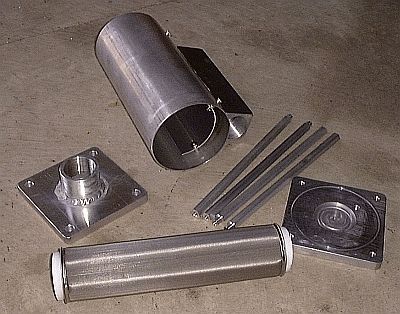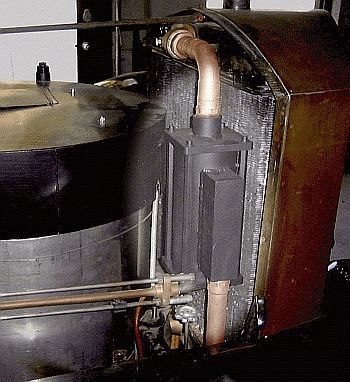|
 The
steam cylinder oil separator I designed for my Model 735 Stanley was
required to meet three primary criteria. First and foremost it had to
remove the vast majority of the oil from the steam (my goal was 80% or
more). The replacement boiler for my Model 735 would be the Stanley
condensing car design where the steel flues would be welded to the bottom
flue sheet thus the boiler design will tolerate steam cylinder oil. The
steam cylinder oil separator I designed for my Model 735 Stanley was
required to meet three primary criteria. First and foremost it had to
remove the vast majority of the oil from the steam (my goal was 80% or
more). The replacement boiler for my Model 735 would be the Stanley
condensing car design where the steel flues would be welded to the bottom
flue sheet thus the boiler design will tolerate steam cylinder oil.
The second requirement was that the
separator had to be small and installed on the car without any modification
to the car itself. Some steam oil separators I had examined required
frame modifications or other similar changes to the car. At least one
unit was over 3 feet long and of sizeable diameter and to me looked like it
didn't belong. For me, keeping the car as original appearing as
possible is a prime concern. In fact my intention was that the steam
oil separator could be removed from the car and there would not be any
indication that it ever had one installed to start with.
The final criteria was that it be
easily serviceable. I wanted to be able to drain the oil from it
easily as well as be able to disassemble it quickly for periodic inspection
and cleaning. In addition to my three primary criteria the unit needed
to be light weight, not costly to make, could not restrict the exhaust steam
flow from the engine (that would mean a reduction in engine efficiency), had
to look like it belonged on the car, and of course had to handle steam and
water temperatures and pressures present in the exhaust from the engine
(after passing through the feed water heater).
As the photograph indicates (bottom
of the photograph) the heart of the separator is the stainless steel filter
cartridge from Rosedale Products (part number 10-100-C-T-S-DOE)
www.RosedaleProducts.com. The
filter cartridge that I chose is ten inches in length with Teflon gaskets on
either end. It is a 100 micron non-pleated filter and includes a
support layer of screen underneath to keep the filter element from
collapsing. It is housed in a four inch diameter aluminum tube and the
filter and aluminum tube are captured between a pair of aluminum end plates
which are tied together with four hexagonal retaining rods. O-rings on
the aluminum end plates insure sealing of the cartridge and aluminum tube to
the end plates to prevent leaking. On the side of the aluminum tube is
an inlet port for the exhaust steam coming from the feed water heater while
the steam leaving the separator flows up the center of the filter and out
the upper end plate. I've further increased the filter area by loosely
stuffing the center of the filter cartridge with stainless steel wool.
Inside the aluminum cylinder, between the filter and the inlet port is a
baffle that helps distribute the steam around the filter instead of letting
it impinge directly onto the filter as it enters the separator. In the
lower end plate is a port for draining the steam cylinder oil off. The
steam oil separator is held in place by its 1-1/4" copper piping.
Removal of the unit for cleaning involves loosening the two 1-1/4" pipe
unions on the copper pipe attached to the separator and lifting it out.
Loosening the retaining rods allows the unit to "fall apart" (this needs to
be done over a tub as steam cylinder oil is everywhere).
The separator works fine and meets
my expectations. While it definitely doesn't capture 100 percent of
the oil in the exhaust steam it does capture a significant amount (I'd
estimate at least 90% to perhaps 96%). The water in the water supply
tank will become cloudy after a long day of driving (and multiple refillings)
but it does not have floating globules of steam cylinder oil as found with
condensing cars not steam cylinder oil separator equipped. I have
found that the separator will collect water due to condensation if I park
the car and don't open the oil drain. It's become part of the ritual
when stopping the car for a period of time to open the separator drain valve
(the only non-Stanley valve on the car; a ball valve to insure unrestricted
passage through the valve) and allow the oil and water to collect in a small
pail. In cleaning the unit after 250 miles of operation there was
significant steam cylinder oil on all internal surfaces of the unit but no
steam cylinder oil to speak of on the piping between the separator and
condenser or that could be observed in the condenser.
It is also worth mentioning that
some steam car owners add "oil sorbents" to their water tanks to soak up
excess oil. Often used in machine shops to soak up cutting oils from
lathes and milling machines, they are also known as "shop oil pigs" or "oil
soaks". They are the diameter of a sock and are available in various
lengths. Some Stanley owners, when cleaning their water supply tanks,
insert several oil sorbent socks into the tank through an extra drain port
installed in the bottom of the tank for collecting oil finding it way past
the separator and into the tank (the existing drain can not be used as it
has the power water pump suction line and suction line screen blocking most
of the drain opening). The socks are water repellent but they do
collect and hold any oil that finds its way back to the tank. When the
tank is cleaned once or twice during an operating season the oil-soaked
socks are removed and replaced with clean ones. The use of oil
sorbents with a condensing steamer that does not include a steam cylinder
oil separator is only recommended if the sorbents are going to be changed
with every couple of water fillings (they will become saturated with steam
cylinder oil quite quickly).
Click here for a section of the Rosedale
Products catalog detailing filters ~
Rosedale Stainless Steel Filter Cartridges
(PDF file)
Click here for my drawing of the steam
cylinder oil housing ~
Steam Cylinder Oil Separator Design (PDF file)
Click here for the Restoration section of
this website that discusses the Steam Cylinder Oil Separator ~
StanleyMotorCarriage.com Steam Cylinder Oil Separator
Restoration |

 The
steam cylinder oil separator I designed for my Model 735 Stanley was
required to meet three primary criteria. First and foremost it had to
remove the vast majority of the oil from the steam (my goal was 80% or
more). The replacement boiler for my Model 735 would be the Stanley
condensing car design where the steel flues would be welded to the bottom
flue sheet thus the boiler design will tolerate steam cylinder oil.
The
steam cylinder oil separator I designed for my Model 735 Stanley was
required to meet three primary criteria. First and foremost it had to
remove the vast majority of the oil from the steam (my goal was 80% or
more). The replacement boiler for my Model 735 would be the Stanley
condensing car design where the steel flues would be welded to the bottom
flue sheet thus the boiler design will tolerate steam cylinder oil.